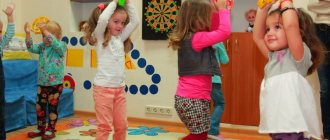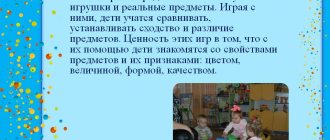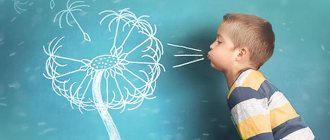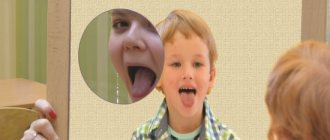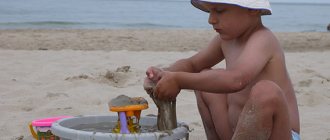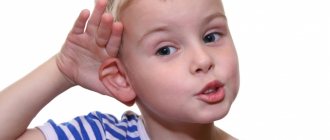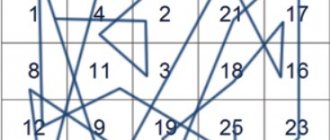Children grow very quickly, and now the baby, who only recently learned to walk, has reached preschool age. Five years is a wonderful period that precedes school. Focus your activities on getting your baby ready for it. Modern school programs are designed for the fact that children already know a lot; the earlier they start preparing it, the better. Children at this age already understand a lot, but still the world remains mysterious to them. And they turn into little whys, asking their parents about almost everything they see. They strive to become as smart as mom and dad, preparing to master the sciences. But classes for 5-year-old children must be structured correctly, because, despite the fact that it is much easier for them to absorb information, children love to play more than sit quietly and listen to the instructions of adults.
What should a 5–6 year old child know?
Five-year-olds are already old enough to move on to more complex activities. They are more resilient physically and mentally, and can concentrate noticeably longer. And, most importantly, they are interested in learning something new. That is, all the factors for successful learning are present.
The adult’s task is to work with the baby at home. Of course, little ones go to kindergartens and developmental groups, but home education remains very important for development.
It must be remembered that the ability to write and read are important factors, but do not determine the level of development of a toddler. At this age, it is important to develop flexibility of perception. For example, it will be useful for parents to direct their efforts to the development of the baby’s mental functions:
- thinking;
- memory;
- imagination;
- perception;
- attentiveness, etc.
It is also very important to pay attention to the development of fine motor skills, because the baby will soon have to hold a hand for a long time. It will be easier for a first grader to concentrate on mastering the material if he does not have to be distracted by holding a pencil correctly in his hand.
Knowledge of basic sciences is very important. Just like mathematics. It is important for a five-year-old child to be able to:
- count to 10 and back (it is not advisable to confuse the numbers);
- visually perceive numbers within ten and be able to write them;
- add, subtract numbers and know what the signs “+” and “–” look like;
- understand what is more, less, equal, and distinguish between the signs “>”, “<”, “=”;
- distinguish between simple geometric figures such as a square, circle, triangle and geometric bodies - cube, ball, pyramid;
- distinguish the shapes of objects, identifying them with geometric figures;
- be able to navigate in space without confusing concepts such as bottom, top, forward, backward, right and left, understand what is further and closer.
It is very important at the age of five to be able to think logically:
- understand the principles of classification according to any criteria;
- find objects that are superfluous in a group classified according to certain criteria;
- establish patterns;
- continue stories, inventing them based on the picture shown, etc.
Speech is another factor that it is important for parents to pay close attention to:
- It is important for the baby to know his full name, the names of his parents and relatives;
- remember where he lives and phone number;
- speech should be coherent and intonation-colored, with a clear separation of interrogative, narrative, and incentive sentences;
- diction, if possible, should be clear, with expressive pronunciation of all sounds;
- words need to be changed according to cases or numbers;
- you need to be able to conduct both a dialogue and a monologue, argue and ask questions.
The baby should already know a lot about the world around him. For example, to understand what furniture is and what it comes in, to distinguish between items of clothing, household items, food, etc. It is advisable for a child to know the names of fairy tales, at least those that he loves, the names of the characters in these fairy tales, cartoon characters, etc. It is important to know the days of the week in a given order, months and years.
The child must understand the basic rules of etiquette, be able to take care of himself (wash, brush teeth, dress, comb his hair), understand the principles of using the telephone and understand the main rules of the road.
In addition, it is important that a five-year-old can remember from 5-6 visual images, from 4 to 5 words that are not related to each other, and repeat the actions shown by adults.
Emotional development
At the age of five, the child is not yet able to distinguish between bad and good behavior. Like Mayakovsky in the book “What is good and what is bad.”
Not understanding many things, a withdrawn child is sometimes afraid to ask a question himself. First of all, we need to teach you to trust you.
This is achieved by calm and consistent behavior and sincere interest in the child’s affairs and thoughts.
When something is unclear, a five-year-old child goes to mom or dad and asks.
If you brush off the question, he will be offended. The second step in education after trust should be openness.
Trying to impose generally accepted morality on a child without adhering to it is useless. Therefore, even if the question is unpleasant, it must be answered honestly.
It would be great if, after talking with you, your little one leaves happy and decides for himself that he will do only good things and will not do bad things.
You need to teach your child to be an optimist. This is actually very important. All our illnesses are associated with worries and fears, all failures and disappointments are the result of an incorrect perception of reality.
Try a game you can play every night. Remember all the best events of the day for which you can thank God, and stick smiling faces in your children's diary.
An emotionally stable child will find it easier to overcome developmental milestones on the way to adulthood.
Preparation for school
The school curriculum comes as a shock to many first-graders, because they are not accustomed to the strict discipline and strict schedule that exists in most public schools. Parents should work with the baby so that he quickly adapts to the new schedule. This is especially important if the baby has not been to kindergarten.
It is still difficult for the child to maintain attention for longer than 15 minutes. If you want to achieve better results, try to fit tasks into this period of time, then take a break and change your occupation.
The baby will have time to learn to read and write, but what is important to do quickly is to figure out how to develop the child’s perseverance. Popular activities:
- Modeling. Using plasticine, the baby develops not only perseverance, but also fine motor skills. The baby can happily sculpt animals, plants, and characters from fairy tales. And, most importantly, this activity can remain in place for a long time.
- Puzzles and mosaics. Another type of activity that, in addition to perseverance, trains attention and motor skills.
- Drawing. Children as young as five years old love to draw. You can complicate the lesson by telling your little one what exactly to draw. For example, setting the contours that the five-year plan should repeat.
It is advisable to adjust your child’s schedule to the school schedule. Of course, not immediately, but gradually and systematically. The main thing is that the activities bring pleasure to the baby.
MUSICALITY, SENSORY, MOVEMENT
One of the main factors in the proper development of a preschooler at this age remains movement. He must move a lot. This increases his agility, endurance, coordination, develops muscles, and strengthens the skeleton. Therefore, the lesson program should have a lot of space for gymnastics, dancing, exercises, cycling, and all kinds of outdoor games. You can enroll your preschooler in some sports section.
And if motor activity is accompanied by well-chosen melodies, the child will also receive musical development. He will have an improved sense of rhythm, perception of fast and slow music, sad and cheerful.
Advice
At this age, a preschooler can be given to listen not only to children's melodies, but also to classical ones. He already has his favorite tunes, to which he begins to dance or hum.
Sensory perception is, first of all, the development of tactile sensitivity. The baby should have the opportunity to touch a variety of materials and textures: soft, hard, smooth, rough, fluffy, prickly, warm, cold. A good game is to recognize objects by touch without seeing them (for example, by taking them out of a bag).
Improving fine motor skills plays an important role. This helps improve all mental abilities: thinking, speech, memory. In addition, good fine motor skills prepare the hand for writing: the child will hold the pen correctly, the hand will strain and get tired less. Games with small objects and materials are good for this purpose: cubes, construction sets, mosaics, sand, cereals. This also includes finger games, tying shoelaces, fastening zippers, unscrewing corks, drawing, appliqués, and modeling.
How to set a goal
The peculiarity of a developmental lesson is a correctly set goal. The main goal at the age of five is to transform the play form of activities into learning with the least traumatic consequences for the child. But at the same time, the training program should include a more extensive list of goals, in particular:
- English lessons - so that the child can communicate freely in a foreign language.
- Interesting stories and demonstration of something new - to arouse educational interest.
- Drawing - to develop creativity.
- Solving logical problems - to develop intellectual abilities.
- Walking in the fresh air is for physical health.
The main thing is that the chosen type of classes forms in the future student a positive attitude towards studying at school. But at the same time, we should not forget about the quality and richness of the material supplied.
ATTENTION – ATTENTION
In order for a child to grow up attentive, be able to concentrate and quickly respond to any changes, it is important to train his attention. You can start as early as 4 years of age. At the same time, it is also not necessary to purchase expensive manuals: the suitable “equipment” is always at hand.
For example, you can play these games.
- Variations on the theme “edible - inedible” (sweet - unsweetened, flies - does not fly, clothes - not clothes).
- "What's new?" (on the table, in the picture, in the guise of dad, in mom’s clothes).
- “Find the differences” (in two pictures).
- “Caravan” - the mother names the animal, the child repeats it and adds his own. Mom repeats both and adds a third. You need to repeat in the order in which the animals are named. They play until someone gets lost.
- "What changed?". During a morning walk, mother and child try to remember everything that surrounds them, and in the evening they compare what has changed (someone hung up the laundry, old women sat on a bench, a car drove up to the next door);
- Close your eyes and name as many different sounds as possible in the room (a clock, the noise of a refrigerator, the purring of a cat) or outside the window (cars driving, birds singing, the wind rustling).
- Close your eyes and tell what order is on the shelf, on the table, what mom is wearing.
It is important to start with easier tasks, gradually making them more difficult, and not forgetting to praise your child for success.
What you need to know when organizing training
The training of five-year-olds should take into account all types of activities that are significant to them. The lesson package includes:
- lessons on the basics of the native language, as it is fundamental for learning correct speech and reading;
- teaching the basics of mathematics - the basics of geometry, arithmetic;
- tasks to improve attention, memory and logic;
- formation of a knowledge base in biology, at least in terms of explaining the difference between insects, birds and other animals;
- lessons on developing a good attitude towards nature and ecology, so that the child understands: you cannot litter;
- learning common household activities such as how to use a kettle, vacuum cleaner and other equipment;
- explanation of natural and astronomical phenomena such as the change of seasons, days, as well as weather factors such as rain, snow, fog, etc.
Five-year-old children love to draw or design. This must be taken into account when organizing training.
If the activity is interesting to the baby and its presentation suits him, the child will be able to study without getting tired for about two hours with variable concentration. But it is important that activities change during this time. For example, we spent half an hour drawing, then looked at pictures of animals, put together a puzzle, and so on until the time ran out.
Children are already moving from playful work to learning, but they also love to play, so be prepared to take short breaks during classes. During this process, for example, you can show your child an educational and interesting video.
Consider a few nuances of work:
- five-year-old children still have involuntary attention; they can be distracted by any little thing;
- it is difficult for a child to control his emotions, so tears are quite possible due to failure;
- short-term concentration.
This complicates the learning process, but under the strict guidance of the parent, the child will be able to learn as much as possible from the information offered.
Lesson: “Hot and cold”
A simple game allows you to develop spatial concepts, memory, thinking and attention. Hide the prize in advance in a place accessible to the child. Ask him to find the hidden thing, give the little participant hints with the words “hot” - it means close to the prize and your five-year-old child is moving in the right direction and “cold” - it means the direction for the search is chosen incorrectly.
You can play this game vice versa, let your son or daughter hide the toy and show you the way to it using similar words. The adult’s task is to find the prize, the child’s task is to correctly give directions using the words “hot” and “cold”.
Game: “What’s missing”
A game that helps develop attention. You will need a set of different items, these could be toys, pencils or any safe items. At first you can use 5-7 items, later complicate the tasks by adding more and more attributes.
The task is to find an item that is missing. Give the little participant time to remember all the objects, and after he turns away, you need to remove one object. If the child correctly guessed which item is missing, then let him hide some attribute from you in the new game.
You can supplement the lesson with tasks like: arrange the objects as they stood, name the color of the object that is missing, arrange the toys by height.
How information is perceived
As you've probably heard, girls develop a little faster than boys, so by the age of five they are already more diligent, attentive and able to concentrate for longer periods of time. With the help of educational toys for children 5 years old, boys can be improved so that they perceive information as well as girls.
Regardless of gender, children need to develop the following perceptual characteristics:
- Sustainability of attention. This means that children should learn to concentrate longer, even on things that are not very interesting to them.
- Switching attention. The child must learn to quickly switch from one activity to another. He will need this at school, when there is only a short break between classes.
- Share attention. A five-year-old needs to learn to observe two or more objects. For example, conduct a graphic dictation, when the child simultaneously listens to what the person reading the task says and concentrates on the drawing in his notebook.
To develop these properties, you need:
- monitor the baby’s emotional factor;
- develop his interest in the lesson being conducted;
- to form strong-willed qualities, thanks to which the child will force himself to learn.
As practice proves, all this can be easily achieved by regularly performing exercises.
What types of activities are best?
The main secret of success is a playful form of educational activities for children. Kids love to play; they do not need to be forced to do something if it is done in the form of a game. Taking this feature into account, educational activities with children 5 years old will be more productive. Moreover, there are a lot of games. Some teach math basics, while others develop speech, motor skills, and social skills. In addition, with the help of games, you can develop perseverance in a child, instill the rules of good manners and behavior in society.
If you want to develop your child’s abilities, engage in creativity with him:
- drawing;
- folding mosaics;
- design;
- sculpting.
This allows the five-year-old to develop imagination and fine motor skills. But classes will be more beneficial if you use special educational toys.
LEARNING MATHEMATICS
The first thing that comes to mind here is numeracy skills. Because it is still difficult for a child to master calculations. How to teach a preschooler to count?
A child can understand how a specific number relates to the designated number, for example, using counting sticks or cards that depict the number and various objects in the corresponding quantity.
To reinforce counting in order, you can use coloring pages that require you to connect numbered dots.
Also, the consolidation of ordinal counting is facilitated by the constant recounting of surrounding objects: houses, benches, birds, steps on the stairs, apples in a vase.
Mathematics is also geometry. By this age, the child should already know basic geometric shapes. Now it is important to consolidate this knowledge, as well as develop the preschooler’s thinking by playing interesting games with figures. For example, you can fold triangles into rectangles, squares, rhombuses, and other triangles. You can make rectangles from squares.
It is also interesting for children at this age to draw using geometric shapes (everyone knows that a triangle is a skirt, a circle is a sun, a triangle with a rectangle is a house). Also, the child can already compare figures by color, shape, size.
Educational toys
It can sometimes be difficult to choose educational games for 5-year-old girls, as well as for boys, but there are universal toys that are suitable for children of any gender and will help them quickly and efficiently prepare for school. And they will do it in the playful manner that children love. Let's take a look at the most popular games for five-year-olds.
- "Games with numbers from 1 to 150." Teaches children numbers, helps them master ordinal counting and gives an idea of other simple mathematical operations. Two types of games are used: coloring by numbers and connecting by dots. In addition to developing math skills, problems will help develop fine motor skills.
- “Development of thinking. Logics". The tasks are intended for children from 4 years old. The baby will work by comparing pictures, analyzing sequences, assessing the plausibility of the situation.
- "Geography, or the Great Journey." The purpose of such games is to introduce children to the countries of the world. The child will learn this in a game format.
- Wooden board “Teaching numeracy”. It is a double-sided board with wooden counters, multi-colored sticks and a dial. Not only is it suitable for learning simple math operations, but it also helps your little one learn colors and learn to tell time. And on the reverse side you can draw on the board with chalk, which is also included in the set.
- Magnetic alphabet "ENGLISH ALPHABET". This game will help your little one learn a foreign language faster. The toy is easy to use, so your child may not even need a companion.
- “Nikitin Squares”, 3rd level. It consists of multi-colored squares cut into different geometric shapes. The child must assemble the finished figures, focusing on the color and shape of the pieces. As a result, the baby gets acquainted with the concepts of “part and whole”, “shape and color”, develops logic, spatial thinking, etc.
- Manual by M. Montessori “Map of the Hemispheres”. Allows you to explore the world in a more interesting manner than with a textbook. The toy is made in the shape of a wooden tablet. There are seven multi-colored continent inserts, a two-dimensional model of the Earth's hemispheres. The benefits of the game are obvious: it forms an idea of scale and its decoding, and expands the vocabulary of geographical concepts. The child learns to use different sources of information, etc.
- The book “Complete, erase, paste. Colors". In such notebooks, a child can draw in it several times, since the pages are laminated and what is drawn can be easily erased.
In addition to the listed toys, parents can choose other, no less interesting and useful games for their kids. In stores now, entire departments are dedicated to educational toys for children of all ages.
DEVELOPING SPEECH
If a child has problems with pronunciation, speech classes should include articulation exercises for each complex sound. You may need the help of a professional speech therapist.
In general, good speech development activities for a preschooler at this time would be:
- poems, songs learned by heart;
- discussion of plot pictures or works read;
- solving riddles;
- listening to audio stories;
- discussion of everything that happened to the child during the day;
- familiarization with sounds and letters;
- determining the first letter in a word, dividing the word into syllables.
Speech skills can be developed with simple game exercises. You can ask your child:
- “What happens...?” (long, red, hot, sharp, etc.);
- "What happens if… ?" (the ball will fall into the water, a black cloud will appear in the sky, I will eat the snow);
- “What can you do...?” (with an apple, a book, a ball, cookies, scissors...);
- "What do you mean where?" (what items are in the bedroom, hallway, kitchen; in which room is there a TV, bed, frying pan, hanger...);
- "Who is this?" (for example: long-eared, gray, coward - who is this?).
GAMES TO DEVELOP LOGICAL THINKING
At this age, the child should already be able to generalize and differentiate objects according to a certain characteristic, work according to a model, and build simple reasoning to solve any problems.
In order to stimulate a preschooler to think logically, you can offer him a variety of games. These can be either store-bought development toys (sorters, puzzles, construction sets, children's lotto) or completely household ones.
For example, your child will have to use their logical skills in the following tasks.
- He is asked to generalize objects according to some characteristic (name everything round in the room, everything yellow, everything soft).
- Determine how two pictures or toys are similar and how they are different.
- Choose identical objects from a variety of objects (balls, bunnies, cubes, etc.).
- Assemble a building from a construction set according to a model.
- Find an extra item from several and explain why it is extra.
- Find paired objects (both real and on cards or pictures). The child will have to determine the sign by which to look for a pair (for a plate - a spoon, for a hat - a scarf, for a chicken - an egg).
- Find a way out of the drawn labyrinth (they are often found in children's educational books or magazines). Variations of such “confusions” can be different: help a cat catch a mouse, meet a dog with a puppy, find a key for Pinocchio, etc.



